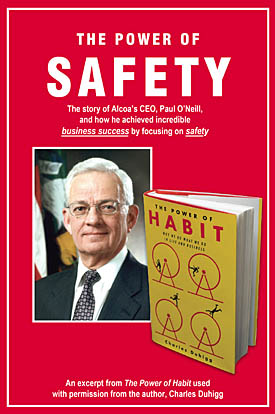Comments
- No comments found

Paul O’Neill was appointed CEO of aluminium giant Alcoa in 1987. He is particularly remembered for his decision to focus on one key priority, safety.
His first speech as CEO was to a group of investors and analysts. He started by saying, “I want to talk to you about worker safety.” He continued, “I intend to make Alcoa the safest company in America. I intend to go for zero injuries.” The audience was shocked and confused. This was not what they expected from an incoming CEO. Where was the financial and marketing strategy? Where was the stock price heading? Many analysts issued sell recommendations after the meeting finished.
O’Neill made safety the cornerstone of ALCOA’s operations. His commitment to safety wasn’t merely a corporate initiative; it was a deeply ingrained value that permeated his every action and which ultimately reached every level of the organization.
O’Neill understood that prioritizing safety wasn’t just a moral imperative; it was also smart business. By focusing on safety, he aimed to create a workplace where employees felt valued and protected, leading to increased morale, productivity, and ultimately, profitability. Under his leadership, Alcoa streamlined and improved operations. It saw a significant reduction in workplace accidents and injuries, showcasing the tangible benefits of his safety-first approach.
Paul O’Neill took specific and visible actions to improve safety:
Implemented a Zero-Injury Goal: O’Neill set an ambitious target of achieving zero workplace injuries. This goal served as a rallying point for the entire organization, emphasizing the importance of safety as a non-negotiable priority.
Established Safety Committees: O’Neill formed safety committees comprised of employees from various levels of the organization. These committees were tasked with identifying safety hazards, developing safety protocols, and promoting a culture of safety awareness.
Invested in Training and Education: O’Neill allocated resources to provide comprehensive safety training and education programs for Alcoa employees. This ensured that workers were equipped with the knowledge and skills necessary to perform their jobs safely.
Implemented Safety Incentives: O’Neill introduced incentives to reward employees and teams for achieving safety milestones and demonstrating exemplary safety practices. These incentives helped reinforce the importance of safety and encouraged proactive safety behavior.
Promoted Open Communication: O’Neill encouraged open communication channels for reporting safety concerns and near-miss incidents. By fostering a culture of transparency and accountability, employees felt empowered to address safety issues proactively.
Integrated Safety into Performance Metrics: O’Neill incorporated safety performance metrics into key performance indicators (KPIs) for managers and supervisors. By tying safety performance to managerial evaluations, he emphasized the accountability of leadership in maintaining a safe work environment.
Regular Safety Audits and Inspections: O’Neill instituted regular safety audits and inspections to identify potential hazards and ensure compliance with safety regulations. These audits provided valuable feedback for continuous improvement in safety practices.
Direct Access to the CEO. Most remarkably, O’Neill gave out his personal phone number and said that any employee could phone him directly with a safety concern if their boss was ignoring them.
At an Alcoa plant in Mexico, a carbon monoxide leak affected 150 employees. They were treated and no one died. However the senior excutive responsible for the plant covered up the incident and did not report it. When O’Neill found out the executive was fired.
O’Neill deliberately picked a fight. By taking these proactive measures, he demonstrated his unwavering commitment to winning the fight and improving safety at Alcoa. He created a culture where safety was not just a priority but a core value embraced by every member of the organization.

By setting a precedent for prioritizing safety in a notoriously hazardous industry, he challenged other companies to reevaluate their own safety protocols. His actions spurred a ripple effect, inspiring a cultural shift towards greater emphasis on workplace safety across industries.
Alcoa’s market value increased from $3 billion in 1986 to $27.5 billion in 2000 when O’Neill stood down as chairman, while net income increased from $200 million to $1.5 billion. He went on to become chairman of Rand Corporation and later served as US Secretary of the Treasury under President George W Bush. He died in 2020 aged 84.
He once said, “Part of leadership is to create a crisis.” Leaders must do many things but they should choose one key priority to focus on. Make that the crisis and the fight that must be won.
Paul is a professional keynote conference speaker and expert facilitator on innovation and lateral thinking. He helps companies improve idea generation and creative leadership. His workshops transform innovation leadership skills and generate great ideas for business issues. His recent clients include Airbus, Microsoft, Unilever, Nike, Novartis and Swarovski. He has published 30 books on lateral thinking puzzles, innovation, leadership and problem solving (with over 2 million copies sold). He also acts as link presenter at conferences and facilitator at high level meetings such as a corporate advisory board. He has acted as host or MC at Awards Dinners. Previously, he was CEO of Monactive, VP International of MathSoft and UK MD of Ashton-Tate. He recently launched a series of podcast interviews entitled Insights from Successful People.
Leave your comments
Post comment as a guest